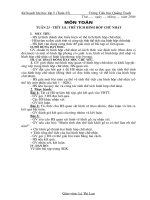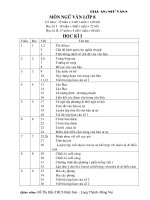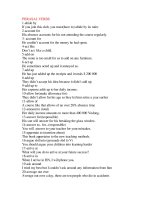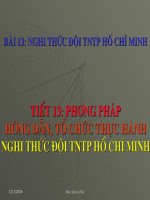G Á 12NC
Bạn đang xem bản rút gọn của tài liệu. Xem và tải ngay bản đầy đủ của tài liệu tại đây (137.56 KB, 6 trang )
LESSON PLAN
Unit Six:
Population
Lessons N
0
6 – 7 Language Focus
Outcomes - By the end of the lesson, the students are able to write fractions
in their written form.
- By the end of the lesson, the students are able to use different
types of relative clauses.
Type of lesson
- Grammar – based (Relative clauses)
Key Vocabulary - fractions - devoted
- supply
Key structures - China’s population is nearly 1.3 billion, which is almost 22% of
the world population.
- Shanghai, whose population density reaches 2,118 people per
sq.km, is ...
Anticipated problems
- Some students seem too shy to share ideas and experience.
Materials - Textbook - Handouts
- Chalk and board - Paper strips
Stage/
Timing
Procedure Aims Focus Materials
1.
Warm-
up
(7 – 9’)
Game: Text messages
- Divide SS into small groups.
- Give out handouts with text messages in a
special form or numbers.
- Ask the groups to translate or write the
messages into full English form.
- One correct translation will earn the group 1
point. The groups with more points will win the
game.
This is the handout:
1. R U OK? 4. I’ll B L8 6. Y R U L8?
2. C U B 45 5 I O U 7. W8’n 4 U 4 ½ hour
3. gr8!
Expected answers: 1. Are you OK?
2. See you before 5:00
3. great! 4. I’ll be late
5. I owe you 6. Why are you late?
7. Waiting for you for half an hour.
- To create
interest
and to
introduce
the
language
point.
Groups -
Handouts
- Chalk &
board
- Chalk &
board
Stage/
Timing
Procedure Aims Focus Materials
- Ask SS what this form is called and when it is
used.
Expected: It’s a kind of shorthand and is often
used in informal notes or email.
- To focus
SS on
form
T – SS
- Ask SS when or where they often see things
like ½, ¾.
Expected: in mathematics, when talking about
proportions ...
T – class
Transition: - Yes, and they are called fractions.
Part of the lesson today will focus on how to
write fractions in full form.
- Chalk &
board.
2.
Word
- Write down on the board: Unit 6 Language
Focus
Fractions - To give
SS an
idea what
fraction is
T – class - Chalk &
- Draw a circle on the board and divide it into 4
equal parts.
- Ask SS how many parts they can see in the
circle, and then elicit ¼, ½, and ¾.
Expected: ¼ = a quarter
½ = a half ¾ = three – quarters
- Tell SS in fractions, the numerator is a cardinal
number and the
numerator
cardinal number
denominator ordinal number
- To draw
SS
attention
to form
T- class - Chalk &
board
+ if the numerator is ≥ 2 (2 or over), the
denominator must be in the plural form. E.g.: 2/3
= two – thirds
(5 – 7’) + quarter is often used for fourth. E.g.: ¼ = a
quarter
- To
practice
writing
fractions in
full form
Individuals -
Textbook
Completing the sentences (p.87 – 88)
- Ask SS to complete the sentences with the full
form of the fractions.
- Tell SS to compare answers in pairs. Pairs
- Call some students to read their answers while
some others write them down on the board.
T-class
3.
Gram-
mar
(10–
- Check with the whole class.
Stage/
Timing
Procedure Aims Focus Materials
15’)
Relative Clauses
- Write these sentences on the board: - To
encourage
SS to
analyse
the
difference
s of the
two
structures
T-class - Chalk &
board
a. The man who is standing over there is our
new teacher.
b. Mr Minh, who teaches us English, is a nice
man.
- Tell SS to underline the relative clauses in the
sentences, and ask them what the clauses
functions in sentence a.
( Expected: It describes the preceding noun, and
is essential to the clear understanding of the
noun, that is, to define or limit the noun.)
- Ask SS if the clause in sentence b does the
same, and what function it has in the sentence.
(Expected: No, the clause in b is not there to
define the noun because it is clear who he is; it
just adds extra information about the man.)
T-class - Chalk &
board
- Ask SS if there is any difference in the form or
structure of the two sentences. (Expected: The
relative clause is b is separated by commas.)
- Elicit and present the types of relative clauses
and their features:
Restrictive/
Defining
relative
clauses
Non –
restrictive/
Non-defining
relative
clauses
Form &
structure
Without
commas to
separate the
clauses from the
noun.
With commas
to separate the
clause from the
noun.
Usage To describe /
identify the
preceding noun,
to make it clear
which one we
mean.
To add more
information
about the
preceding
noun.
Other
features
Object relative
pronouns can
Object relative
pronouns
Stage/
Timing
Procedure Aims Focus Materials
be omitted cannot be
omitted.
Relative
words
Subj: who, that,
which
Obj: who(m),
that, which
Possessive:
whose (for both
people &
things), of which
Adv: when,
where, why
Subj: who,
which
Obj: who(m),
which.
Poss: whose
(for both
people &
things), of
which
Adv: when,
where
(8 – 9’) Activity 1: Error Correction (Task a, p.88) - For SS to
recognize
the
function of
different
relative
words
Individuals -
Textbook
- Ask SS to read the sentences, underline the
words or phrases that are incorrect and write the
correct word or phrase. Tick (√) the sentences
that are correct.
- Tell SS to compare answers with a partner and
then go over the answers with the class.
(10–12’)
Activity 2: Joining the sentences (Task b,
p.89)
- To
provide
some
controlled
practice
- Tell SS to read the pairs of sentences and
combine them using relative words and add
commas where necessary.
- Call on SS to write their sentences on the
boards and check with the class.
(9-10’)
Activity 3: Answering questions using
relative clauses (Task c, p.89)
Individuals
Pairs
T- class
-
Textbook
- Ask SS to answer the questions using the
information provided in relative clauses.
- Tell SS to compare answers with a partner.
- Go over the answers with the class.
(9-10’)
Activity 4: Definitions
- Put SS into two groups, A and B Groups - Cards
- Give each group a set of cards. Set A to group
A, set B to group B. (Appendix) - To allow
SS to
make
sentences
Stage/
Timing
Procedure Aims Focus Materials
of their
own
- Tell the groups to take turns to read the
definitions of the words on the cards. And the
students in the other group say what it is. With a
correct word, the group wins 1 point. The group
that wins more points will win the game.
- Give a demonstration: I have a word on the
card in my hand. I’m going to read the definition,
say what it is. “A place where you can buy food,
and many other things”
T-class
(Expected: A supermarket)
- Then show SS the card with “supermarket –
buy food and ...”
T-class
- Check SS’ understanding of instructions and
have them start the game.
- Keep a running total of points for each group on
the board.
- Declare the winner
(7-9’)
Activity 5: Expanding sentences (Optional – to
be left out if out of time)
- To give
free
practice
and
encourage
creativity
Groups - Chalk &
board
- Put SS into small groups.
- Write the following sentence on the board:
This is Tom.
- Tell SS, in their groups, to try to expand the
sentence and make it as long as possible.
T- class
- After the time limit of 5 minutes, the group with
the longest and correct sentence will win the
game.
Sentence Completion
- Give out handouts and ask SS to do the
exercise at home. Complete each sentence with
a suitable relative word. Where more than one is
acceptable, write all the alternatives.
1. The winner, ..... set a new record, is a humble
person.
2. Jack can’t remember .... he lent his car to.
3. The food .... was left was eaten the following
day
4. I can never forget the day .......... I met you.
5. The people ............ were waiting outside were
becoming impatient.
Expected answers:
1. who 2. who/ whom 3. which/ that









